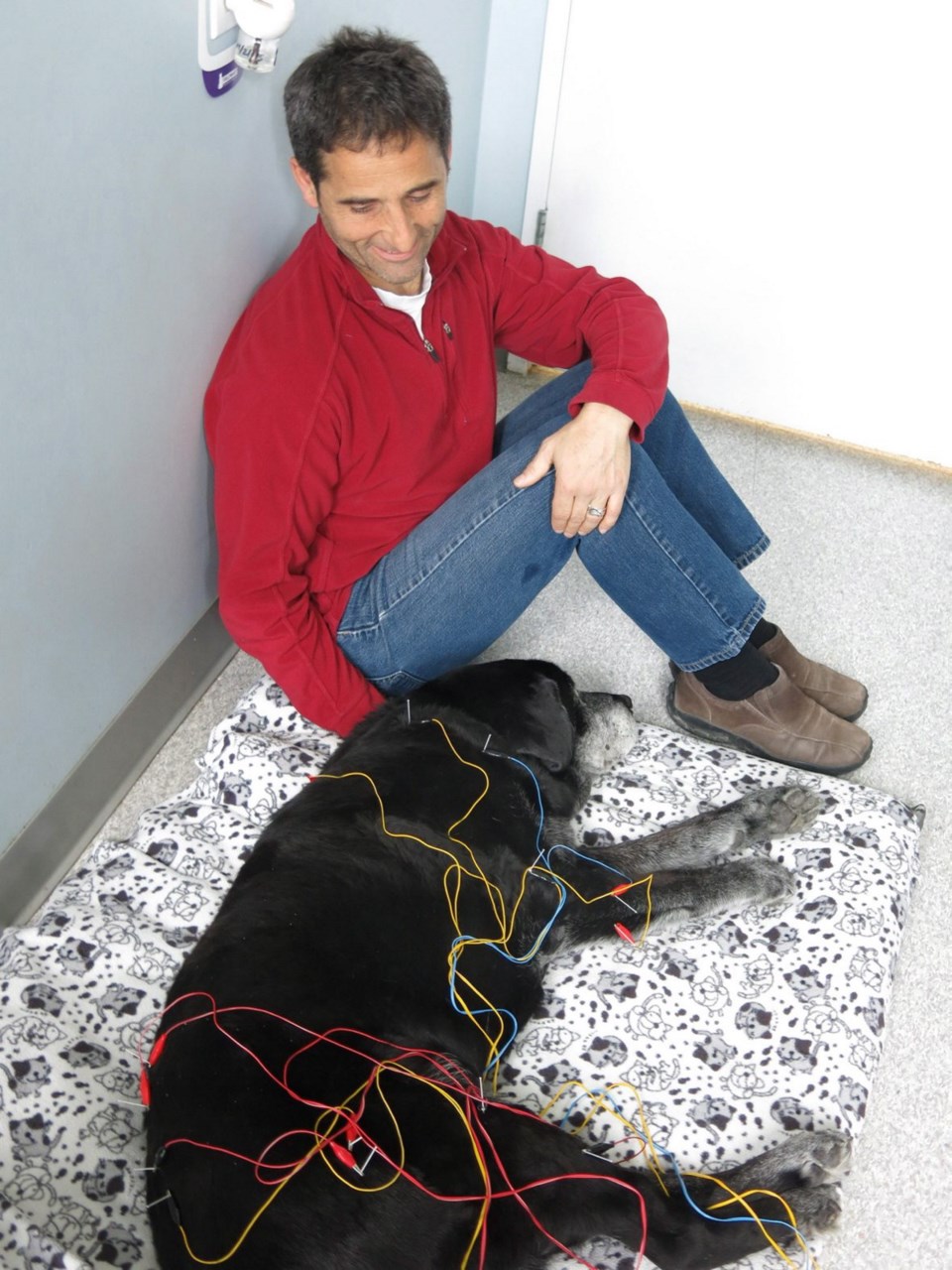CALGARY — Chilko has seen better days. A good walk for the 15-year-old black Labrador is now 18 to 24 metres. The grey hair on his chin is a testament to his advanced age.
Chilko’s owner, Gino Furano, is not willing to say goodbye to his constant companion just yet. Furano has embraced a holistic approach to the painful ravages of his dog’s old age.
Furano has been taking Chilko to the Calgary Holistic Veterinary Clinic for acupuncture for three years and said the hour-long sessions appear to be working.
“Most of the time he’ll just fall asleep,” Furano said as he sat on the floor with Chilko’s head in his lap.
“When we first brought him in, we noticed a significant change in his mobility. Then there was arthritis somewhere on his right side. He’s still mobile. He’s eating. He’s happy and he’s doing really, really well,” Furano said. “The acupuncture relieves some of the stress. Now I just think he has a lot of aches and pains in his joints. This is just quality of life now.”
Chilko barely seems to notice when veterinarian Dr. Yanhui Qi inserts needles and hooks them up to a low-level electrical current.
“It works the same as on humans,” Qi said. “We know that it’s working by observing after the treatment if there is less pain and they are moving easier.”
The cost is $220 for the initial consultation and treatment. Followup treatments run between $73 and $100.
Qi grew up in rural China where, he said, the use of acupuncture has been used on horses and cattle for thousands of years.
It is more rare in North America, where the efficacy of animal acupuncture has been questioned. But recent articles suggest there is evidence that it is useful in managing pain in cats and dogs.
Joint guidelines written by the American Animal Hospital Association and American Association of Feline Practitioners say: “There is a solid and still growing body of evidence for the use of acupuncture for the treatment of pain in veterinary medicine to the extent that it is now an accepted treatment . . . for painful animals.”
“When I started at this clinic 16 years ago, people were skeptical, but now more and more people want to try this kind of treatment for their animals,” Qi said. “With acupuncture, we are able to save animals and improve the quality of their lives.”
Miki Zahner took in her Maine coon cat, Tony, after he injured a ligament in his leg in a fight with another cat. “He’s felt a lot better. He’s no longer limping,” Zahner said. “I think he’s only had three treatments. He’s jumping again and so he’s doing just fine. He falls asleep during it.”
Zahner became a believer after taking another cat for acupuncture several years ago. “When [Qi] first mentioned it to me I kind of rolled my eyes at him,” she said. “But the treatments were fantastic.”
Human treatments can work for animals
Acupuncture is not the only health care for humans that is also available to pets. Others include:
Physiotherapy: Can achieve similar benefits seen in human physical rehabilitation to restore function after surgery or injuries, reduce pain and inflammation or improve general well-being in old age. It can include hydrotherapy (exercises or treadmills in water), gentle stretching and manipulation of limbs (yoga), massage and simple exercises such as stair-stepping to increase strength and balance.
Dental care: Dog and cat owners are urged to brush Fido and Fluffy’s teeth regularly. That’s not always easy, so veterinarians specializing in animal dentistry can provide dental cleanings, extractions, root canals, crowns and cavity repairs.
Diagnostic imaging: Includes X-rays, CT scans, ultrasounds and magnetic resonance imaging to diagnose or confirm everything from fractures to tumours.
Radiation therapy: Uses complex equipment to shrink or destroy cancerous cells. Usually administered over weeks.
Radioiodine therapy: An option to treat hyperthyroidism. Involves injection of radioactive iodine. It can only be performed at specialized veterinary centres as it involves radioactive material. Pets have to be isolated for a time.
Diabetes treatment: Insulin injections administered by owners are considered the benchmark therapy. The treatment involves careful monitoring of insulin levels, diet and exercise. In-clinic procedures can include laboratory tests to measure blood glucose levels and liver enzymes. Complications require immediate veterinary care.
Major surgeries: Some of the same operations performed on people can be performed on animals, including pacemaker implants, gastrointestinal surgeries and kidney transplants.
Reiki: Channels healing energy through the hands to the animal to relieve pain and provide calming influence. Some practitioners make house calls. Cats seem to be especially receptive.



